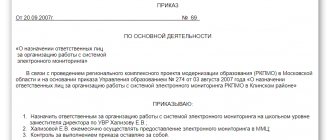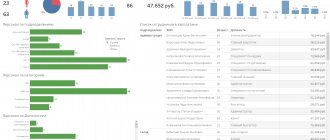Each organization carries out its functional responsibilities based on legal norms, regulations and job descriptions.
These documents establishing the title and regulating the work of the company are mandatory, drawn up and can be changed in working order.
One of the important documents on which the functional life of specialists is based is the job description.
It is designed to ensure that the employee understands what rights and responsibilities and powers he has, and how his work differs from the functions of other employees.
This document is of great importance in adjusting and establishing relationships between colleagues , which should be based on helping each other and non-conflict.
Each specialist usually has his own title document.
Based on the activities of the company, the job description of an administration specialist will differ in all respects from its prototype in the field of technology and engineering.
What is a job description
This term refers to a document that is drawn up for a specific group of positions or individually.
It must specify what functions are under the jurisdiction of a particular specialist, his range of responsibilities, what manipulations he has the right to carry out within the framework of his powers, as well as enforcement measures (responsibility for violating deadlines and justified reduction in quality indicators).
In order to develop a job description, the head of the department first of all uses the regulations in force in the organization.
If it is not drawn up in accordance with the rules, then employees often have conflict situations regarding the division of labor and working relationships , since specialists do not understand the essence of the documents issued to them against signature, designed to regulate their activities.
Why are job descriptions written?
When developing job descriptions, the head of a department or enterprise is guided by regulations at both the regional, federal and local levels.
When drawing up this document, the company’s management set several tasks :
- divide work responsibilities between employees, coordinate their understanding of their own activities;
- improve the psychological climate and situation in the team, eliminate the possibility of conflict situations;
- to delimit the rights, duties and powers of specialists, to determine their responsibilities. See here about the types of disciplinary sanctions;
- to relieve the workload of employees who are forced to combine several positions and distribute it evenly;
- establish an incentive system (psychological and financial);
- stabilize the level of management in the organization.
With the help of the job description, all aspects that are fundamental for the enterprise to improve the management apparatus and personnel must be implemented.
Who writes the job description
The choice of the person responsible for the development of this document depends on the size of the organization and the number of people involved in work activities.
If the company is large in size and consists of several departments, then a standard job description for a specialist is drawn up by the head of each department for each group of positions.
If the company is small, employing from 10 to 25 people, then this document should be developed by an employee of the HR department .
A personnel employee in such a situation is engaged not only in maintaining work books and staffing, but also in drawing up job descriptions.
What to do if a change to a document is necessary?
Changes to the staffing table are approved on the basis of an order signed by the manager. Next, HR department employees make the appropriate changes to the document as prescribed in the order. Thus, full responsibility falls on the head of the organization.
The document is adjusted in connection with a change in the salary of workers . In this case, the employer must inform employees about this two months before issuing an order to amend the staffing table. The names of positions and new salaries are indicated first in the order and then in the schedule. Personnel officers first familiarize themselves with the order and sign it.
As a rule, some period passes from the date of issue of the order to amend the schedule to the date these changes enter into force. Because often, after an amendment to the schedule, there follows an amendment to employment contracts.
You will learn how to introduce a new position into the staffing table here.
Contents of the job description
The job description of a department specialist can be developed not only for an existing position, but also for one being introduced into the work.
The stages of this process must be carefully thought out, agreed upon and logically arranged in a certain order. The stages of compilation can be considered :
- evaluative (the compiler evaluates the enterprise’s capabilities to implement a new position, determines the person’s place in the entire organizational structure, and plans his activities);
- drafting (the document is created in the form of a draft, responsibilities and rights are determined);
- it is agreed with the manager (all inaccuracies and shortcomings are subject to correction);
- the document is subject to approval by the boss (registration and signing);
- employees familiarize themselves with the instructions against signature (one copy is given to them, the second remains in the HR department).
Here you can learn more about the features and purposes of compiling an employee profile.
The following sections are usually recorded in the job description:
- name of the position (already existing or newly introduced);
- general aspects;
- functional features;
- employee responsibilities;
- employee rights;
- liability of a specialist that occurs in case of failure to perform or poor quality performance of activities.
In this article you can learn more about the collective agreement and the purposes of its preparation at the enterprise.
These points are provided for each instruction developed within the framework of the activities of a particular specialist.
Why do you need a job description?
Each specialist must understand and be aware of what functions are within the range of his work.
When employees interact, there should be no duplication of work performed.
If several employees perform the same duties, then the organization will not have the opportunity to develop its production and improve , since many areas will remain undeveloped.
Here you can learn about labor disputes and the procedure for resolving them.
The development and approval of job descriptions should occur in stages and sequentially, since each of them complies with legislative norms at all levels of management when drafted.
An employee must be familiar with the list of his functions, rights and responsibilities, powers and the possibility of consequences (liability) for improper performance of his duties.
After studying this document, employees should not only know their functions, but also learn how to communicate without conflict with other colleagues.
Correct design
An information letter about a company must comply with business correspondence standards. There are no strict requirements, but you still need to adhere to some design rules.
A special form can be used for registration, or the letter can be drawn up on a regular sheet of paper. Organization details should be in the upper right corner.
When writing a response letter, you need to indicate the date and number of the incoming letter. The header containing the subject of the letter is located in the center. It is also important to immediately greet the recipient.
In the main part of the letter, state why it was sent, what you want to tell the addressee. You need to use standard template phrases for business correspondence: “We inform you that...”, “In connection with...”, “We inform you that...”. You need to write clearly and orderly, without unnecessary information.
List the annexes attached to the document and briefly describe them. At the end of the letter write: “Thank you for your attention” or “With respect...”
FAQ
What powers does the employer have over the workforce?
The employer has the right:
- conclude, amend and terminate employment contracts with employees in the manner and on the terms established by the Labor Code of the Russian Federation and other federal laws;
- conduct collective negotiations and conclude collective agreements;
- encourage employees for conscientious, effective work;
- require employees to perform their job duties and take care of the employer’s property (including the property of third parties owned by the employer, if the employer is responsible for the safety of this property) and other employees, and to comply with internal labor regulations;
- bring employees to disciplinary and financial liability in the manner established by the Labor Code of the Russian Federation and other federal laws;
- adopt local regulations (with the exception of employers - individuals who are not individual entrepreneurs);
- create associations of employers for the purpose of representing and protecting their interests and join them.
What are the employee’s labor responsibilities to the employer?
Workers must:
- maintain labor discipline;
- perform all assigned work in a timely and accurate manner, and avoid delays in completing tasks;
- use working time for its intended purpose, refrain from actions that distract from the performance of direct work duties;
- comply with labor protection requirements, industrial safety, etc.;
- keep your workplace clean and tidy;
- take care of material assets, equipment, tools.
The job responsibilities of specialists, along with the performance of specific functions provided for by the corresponding qualification characteristics of the position, may provide for mandatory compliance with labor protection requirements at each workplace.
And the job responsibilities of managers are to ensure healthy and safe working conditions for subordinates and control over their compliance with the requirements of regulatory legal acts on labor protection.
Most often, the reason for an employee’s failure to fulfill his job duties is laid down already when developing a job description .
Vagueness, incomprehensibility and ambiguity of wording leads to the fact that the employee:
- simply does not understand what functions it should perform;
- uses language as an excuse and basis for doing nothing or justifying wrong actions.
Duplication of the same duties in the job descriptions of employees occupying different positions can also cause failure to fulfill the problematic function of the employer - the one that is “one for two”.
The employee becomes familiar with his duties and functional rights when concluding an employment contract. By putting his signature on the employment contract, the employee thereby assumes the responsibilities listed in the contract. If the job description is drawn up as an annex to the employment contract, which is an integral part of it, it is necessary that the employee also signs the instructions .
Only from this moment does the employer have legal, officially documented grounds to require the employee to fulfill his work duties. This right was granted to him by Part 1 of Art. 22 Labor Code of the Russian Federation. For the employee, part 2 of Art. 21 of the Labor Code of the Russian Federation prescribes the conscientious performance of one’s labor duties.
Who develops labor safety instructions, we
Another option (and, perhaps, the most reliable!) is to entrust the development of labor protection instructions directly to us. The accumulated experience will allow us to do this not only quickly, but also accurately: over the years of working with companies from very different fields, we have learned to reflect in the instructions both the wishes of management and the subtleties of the profession.
Pros : many years of experience, qualified approach to business, taking into account all the intricacies of the organization’s work, short development time, unlimited consultations.
Cons : none.








